Calf Exercises
Overview
- The calf (Latin: Sura)muscle is located in the back of your lower leg, behind the shin bone (tibia). It is made up of three different muscles: the gastrocnemius, soleus, and plantaris. Together, these lower leg muscles allow you to walk, run, jump, stand on your toes, and flex your foot (push your toes down regarding the ground).
- The gastrocnemius and soleus are the biggest muscles in this region. The gastrocnemius is the most superficial muscle, with two heads: medial and lateral. The gastrocnemius’s two heads converge to form a confluent muscle belly. The lateral head develops from the lateral surface of the lateral femoral condyle, while the medial head develops from the posterior, non-articular part of the medial femoral condyle. The gastrocnemius muscle belly joins the soleus muscle distally to form the calcaneal tendon (also known as the Achilles tendon), which attaches to the posterior calcaneus.
- The tibial nerve supplies to the calf muscle while the plantarflexes supply the ankle joint. The soleus is a large, flat muscle found deep within the gastrocnemius. The plantaris is a small muscle with a very long tendonous portion. The tendinous portion is easily mistaken for a nerve. The plantaris muscle originates in the lateral supracondylar line in the femur as well as is completely absent in up to 10% of the population. The muscle descends medially and eventually forms a tendon that runs lower the leg, in between the gastrocnemius as well as soleus. This tendon combines with the calcaneal tendon.
- Calf Exercise is an excellent way to strengthen and stretch your lower leg, with numerous health benefits.
- Calf Exercise include both stretching and strengthening exercises. Strengthening exercises promote joint flexibility, increased mass of muscles, stronger bones, weight control, and balance. Stretching exercises improve physical performance, reduce the risk of injury, allow joints to move through a full range of motion, and increase muscle blood flow. Allow the muscles to work more effectively, improving your ability to perform daily tasks.
Anatomy
The calf muscle is situated at the back of the lower leg. It has two muscles: the gastrocnemius as well as the soleus.
These two muscles meet at the Achilles tendon, which is directly attached to the heel. Any leg/foot motion uses these muscles.
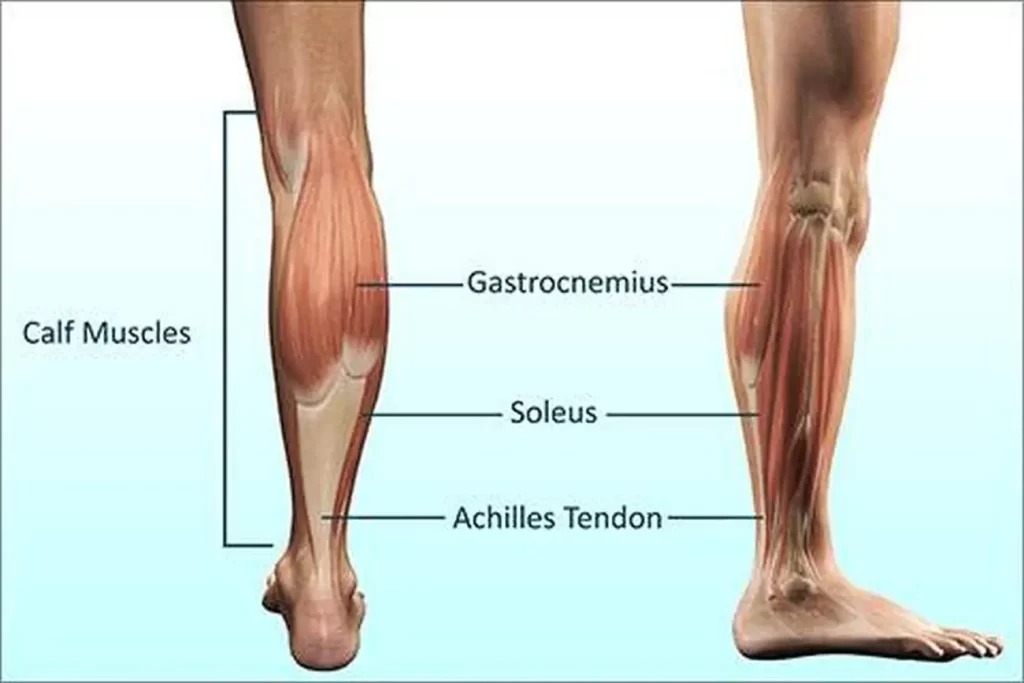
The calf muscle is composed of 2 main muscles:
The gastrocnemius is the larger thigh muscle that creates the bulge beneath the skin. The gastrocnemius has two heads that form a diamond shape.
The soleus has a flat muscle found beneath the gastrocnemius.
The soleus and gastrocnemius muscles converge at the base of the shin muscle. A difficult connecting towel at the bottom of the shin muscle connects to the Achilles tendon.
The Achilles tendon is placed into the heel bone. (calcaneus) A small muscle known as the plantaris runs in between the soleus and gastrocnemius muscles down the length of the lower leg. Providers refer to these three muscles as the triceps surae. However, not every individual has a plantar muscle.
Stretching Exercise of Calf Muscle:
- Calf stretching is an important exercise for increasing lower leg flexibility, reducing the risk of injury providing numerous health benefits. It is the most recommended warm-up exercise, and if done regularly, it will improve your overall fitness level.
- The calves may feel tight for a variety of reasons. The calf consists of two muscles: the gastrocnemius as well as soleus. Walking from place to place and engaging in strenuous exercise regularly put these muscles to work.
- The calf is a network of muscles and tendons on the back and sides of the lower leg. The gastrocnemius muscle is located directly below the back of the knee, while the soleus muscles are located on the side and downward part of the calf. Both parts are connected to the heel via the Achilles tendon. When they lack flexibility, it can affect how you distribute your weight and apply pressure to other parts of your body as you move. As a result, the ankle, foot, and knees may not function properly. This can result in pain, tightness, and even injury, preventing you from enjoying your favorite activities.
- Calf pain can be caused by a variety of factors, including tight and weak lower leg muscles, as well as an injury like a calf pull or strain. The pain may not always be severe enough to prompt you to see a doctor, but it can still have an impact on your fitness and enjoyment.
- Stretching the calf muscles can help relieve pain and muscle soreness. Make sure to warm up with some minutes of cardio or a warm bath before stretching, and always stretch thoroughly after a workout.
Some Stretching exercises of the calf muscle:
- Downward Dog.
- Downward Dog with Foot Pedal.
- Seated Calf Stretch with Resistance Band
- Single-Leg Heel Drop Stretch
- Inchworm
- Forward Fold
- Calf Raise
- Toes on the Wall Stretch
- Lunging Calf Stretch
- Standing Bent-Over Calf Stretch.
- Half-Split Stretch.
- Heel cord stretch with bent knee
- Dorsiflexion Stretch
- Plantarflexion stretch
- Lying Calf Stretch
- Standing Gastrocnemius Stretch
- Standing Soleus Stretch
- Calf Stretch On A Step
- Outer calf stretch
- Inner calf stretch
1. Downward Dog.
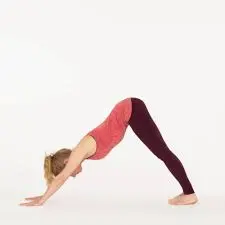
- Begin in a high plank position, placing both hands right beneath your shoulders.
- Pressing your fingers as well as palms, shift your weight back and raise your buttocks to the ceiling, forming an inverted V shape with your body.
- Hold this position and breathe!
- The key to a great calf stretch from this classic yoga pose is to press your heels through the floor. To target the lower part of these muscles, slightly bend your knees while keeping your heels down. This move will also help to stretch your hamstrings, lower back, and glutes.
2. Downward Dog with Foot Pedal.
- Begin in a high plank position, placing your hands right away beneath your shoulders.
- Pressing your fingers as well as palms, shift your weight back to bring your buttocks to the ceiling, forming an inverted V shape with your body.
- Ascend on the toes of one foot while pressing the heel of the opposite foot into the ground. Reverse the motion and repeat the pedaling on the other side. Continue pedaling.
- Your calves, heels, and hamstrings are the main focuses of this intense downward dog stretch.
3. Seated Calf Stretch with Resistance Band
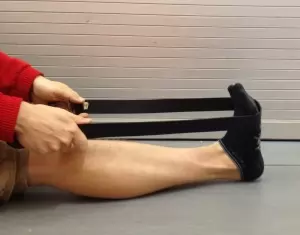
- Sit on the floor, legs extended.
- Loop a resistance band (or whatever tool you’re using) around one foot while holding both sides with your hands.
- Carefully pull your toes regarding your shin until your calf stretches.
- Repeat on the opposite side.
- “Bands are excellent options for people with extremely tight hamstrings and calves to increase range of motion,” Otey said. If you don’t have a resistance band, try a yoga strap, a towel, or something similar.
4. Single-Leg Heel Drop Stretch
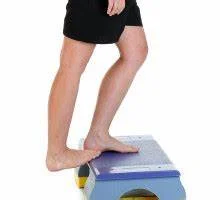
- Place the balls of your feet on the step’s edge as you stand.
- Drop one heel to the floor. Bend your other leg and don’t put too much weight on it.
- Repeat on the opposite side.
- To make this a dynamic stretch, slowly pedal your heels back and forth or lower both heels to the ground and raise them up and down.
- You can perform this stretch on a step, a sturdy box, or the edge of a treadmill.” I enjoy employing gravity for helping stretches,” he said.
5. Inchworm

- Arms at your sides, feet hip-width apart, and erect.
- Bend from the waist as well as place your hands on the floor.
- Walk your hands forward to form a high plank position, keeping your hands flat, wrists stacked under your shoulders, and core, quads, and buttocks engaged. Pause for one second in high plank.
- Return to the starting position by walking your hands back to your feet and standing. This is one rep.
- Your entire body is activated by this dynamic stretch, from your shoulders to your heels. When you walk your hands back to the starting position, your calves join in.
6. Forward Fold
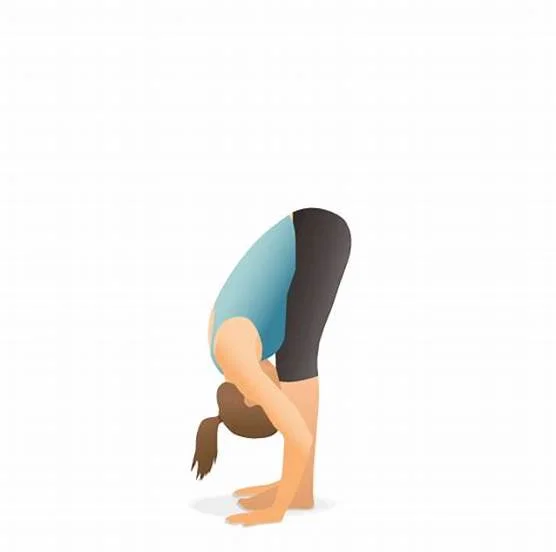
- Stand with your feet together, shoulders back, chest proud, eyes straight ahead, and hands by your sides.
- Breathe in, and as you exhale, tip your chin to your chest, then slowly roll down, bringing the crown of your head to the floor. Imagine moving each vertebra one at a time while slowly folding your chest forward toward your thighs.
- Once you’ve folded forward, you can interlace your fingers around your big toes, clasp your opposite hand around your opposite elbow, or gently press both hands against the floor, as shown.
- This stretch is commonly thought of as a hamstring stretch, but it also loosens your calves. You should also experience a gentle release in your back. If you are unable to touch the floor, you can either bend your knees more or rest your hands on a box or yoga block.
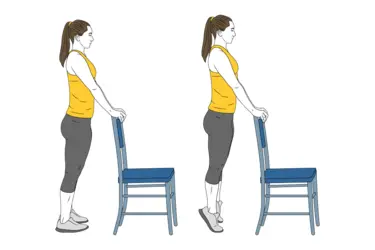
7. Calf Raise
- Stand on a flat surface, toes pointing straight ahead, feet hip-width apart.
- Raise your toes, feeling your calf muscle contract, before lowering your heels to the floor. This is one rep.
- Continue performing reps.
- This dynamic stretch moves your calves through their range of motion.
8. Toes on the Wall Stretch
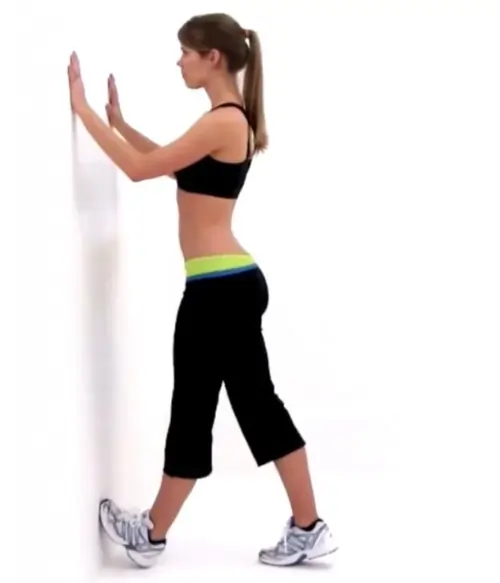
- Stand in a staggered stance in front of a wall, with one foot close to it and the other about a foot back. Keep your palms against the wall.
- Bring your front foot close to the wall, with your heel on the floor and your toes up against it. Put your weight on your front foot and feel the stretch in the lower part of your front leg. (To increase the stretch, increase up on the toes of your back foot while bringing your chest closer to the wall.)
- Hold for a set period before switching sides and repeating.
- To get the most out of this calf stretch, keep your front heel firmly locked into the floor and wear sneakers to maintain a grip on the wall. This stretch targets your lower calf and Achilles tendon.
9. Lunging Calf Stretch
- Stand a few feet away from a wall. If you’re not near a wall, you can simply do this with your hands on your hips (as shown above).
- Place your hands on the wall for support and take one step back into a mini lunge, bending your front leg while keeping your back leg straight.
- Lean into the wall and press your back heel down until it is flat on the ground. The farther your feet have been, the greater the stretch.
- Repeat on the opposite side.
10. Standing Bent-Over Calf Stretch.
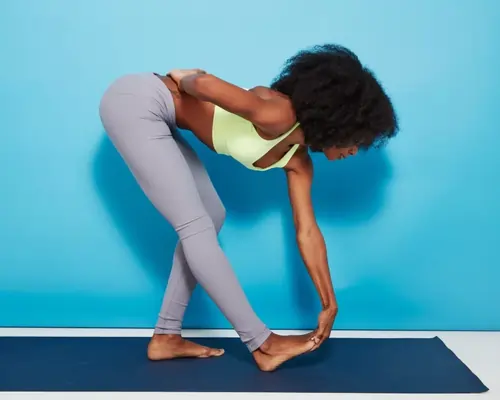
- Stand in your feet staggered.
- Bend your back knee while maintaining your front knee straight as you fold forward, grabbing your front foot beneath your toes.
- Pull your toes up gently, feeling the stretch in your calf.
- Repeat on the opposite side.
11. Half-Split Stretch.
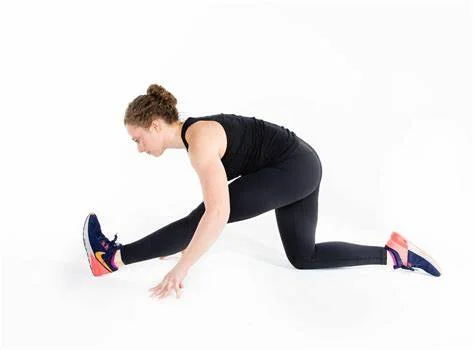
- Begin kneeling with your right knee directly in your right hip as well as your left leg fully extended in front of you. The left foot should be flexed.
- Walk your hands next to your left leg until you feel a stretch in the back of your left thigh.
- Fold your torso over the left leg. If you feel a pull behind your left knee, bend it slightly. Bending your knee will also allow you to feel the stretch in your calf.
- Hold this pose for a predetermined amount of time before repeating it on the right side.
12. Heel cord stretch with bent knee
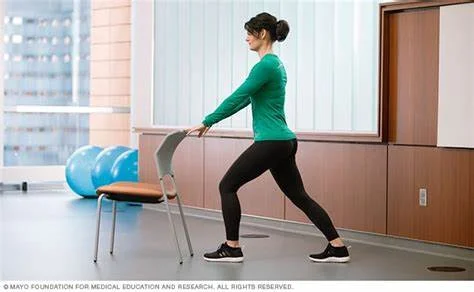
- This stretch needs the use of a wall.
- Stand with your right leg in the direction of your left leg.
- Carefully bend the back (left) knee as well as point the toes inward slightly. Push both hands toward the wall.
- Keep both heels flat on the floor and press your hips toward the wall. Hold this position in place for 30 seconds.
- Perform the stretch on the other side.
- Tip: When doing this stretch, keep your hips focused over each foot and avoid leaning to one side.
13. Dorsiflexion stretch:
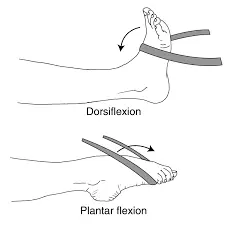
- Sit on the ground.
- Legs extended in front.
- Protect the band of elastic tightly around a solid piece of objects of furniture, such as a heavy chair or table. Wrap the other end of the band with your foot.
- Pull the toes toward the body, and then gently bring them to their original position.
- Repeat the movement 10 times, then switch to the opposite side.
14. Plantarflexion stretch:
- Sit on the floor with your legs extended.
- Cover one end of the flexible band around one foot, then hold the other end.
- Gently point the toes forward before slowly returning to the starting position.
- Do this movement 10 times before switching to the opposite side.
- Tips: Make sure the elastic band provides a comfortable resistance to the movements. If it is not, move away from the piece of furniture and pull harder on the band.
15. Lying Calf Stretch
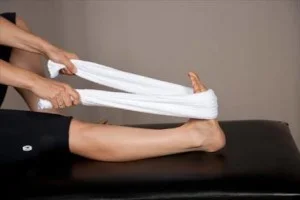
- Starting Position: Sit on the ground with your leg stretched out straight in front of you. Wrap a towel or belt near the ball of your foot, holding the ends.
- Draw your toes and foot up to you, and pull through the towel to increase flexion at your ankle, until you feel a strong stretch in the back of your calf.
- Repetition: hold for 30 seconds and repeat three times.
- Variations: To stretch you’re gastrocnemius muscle, retain your knee straight while performing this exercise. To stretch the soleus, bend your knee slightly.
- To perform a seated calf stretch, sit in a chair with your leg straight out in front of you. Wrap a towel or belt around the ball of your foot, holding the ends. Sit up tall.
- Pull your toes and ankles up toward yourself and pull through the towel to increase the stretch in the back of your calf.
- Holds for 30 seconds and then continues three times.
- Top Tip: a. To stretch your gastrocnemius muscle, keep your knee straight while performing this exercise.
b. To stretch the soleus, turn your knee just (about 20 degrees).. c. Sit upright and avoid slumping forwards.
16. Standing Gastrocnemius Stretch
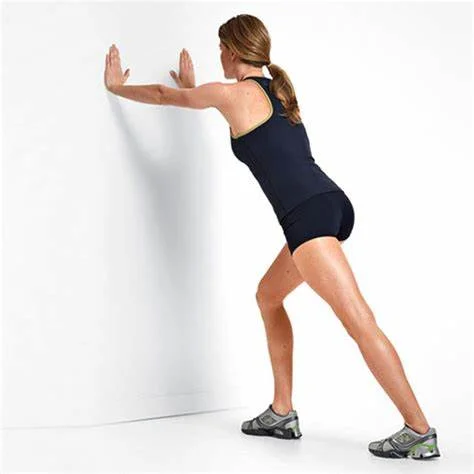
- Starting Position: Stand against a wall and step the leg that will be stretched back behind you. Check that your toes point directly forward.
- Action: Standing tall with your back knee straight, lunge forward to onto your front leg up until you feel a stretch in your back leg’s calf muscle.
- Holds for 30 seconds and then continues three times.
- Notes: a. Maintain a straight back and tall posture. b. Maintain the back of your knee erect with your heel on the ground. c. Check that your toes point directly forward, not out to the side.
17. Standing Soleus Stretch.
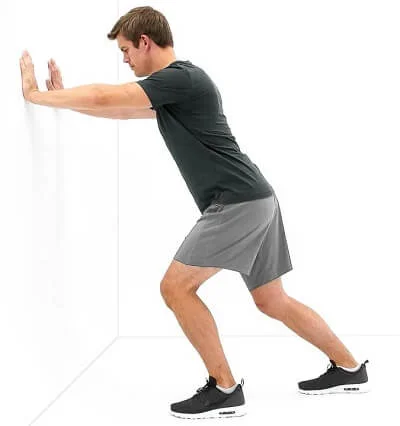
- Starting Position: Stand against a wall and step the leg that will be stretched back beneath you. Check that your toes point directly forward.
- Action: Bend the back knee slightly and lean into the wall while standing tall until you feel a stretch in your calf muscle on the back leg.
- Holds for 30 seconds and then continues three times.
- Notes: a. Keep your back straight and tall, not bending forward. b. Maintain your back knee bent slightly with your heel on the floor.. c. Check that your toes point directly forward, not out to the side.
18. Calf Stretch On A Step: The Ultimate Stretch!
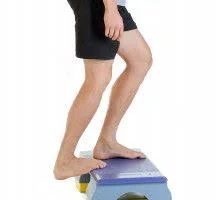
- Starting Position: Stand on a step, with the heel of the leg to be stretched resting against the back of the step. This is my favorite calf stretch.
- Action: Lower the heel by bending the other knee up so you feel a stretch in your calf.
- Hold for 30 seconds and then continue three times.
- To stretch gastrocnemius, maintain the knee straight. For the soleus, slightly bend the back knee during calf stretches. Holds for 30 seconds and then continues three times.
- If you’re doing the exercises on the stairs, you might find that having your other foot on a higher step gives you a better stretch.
19. Outer calf stretch
- Stretch the outer calf to target the lateral head. Stretches the lateral head of the gastrocnemius (outer side).
- Starting Position: Stand leaning against a wall, with your leg stretched back behind you. Turn your toes inwards, then lean forwards, until you feel a stretch in the back of your calf, primarily on the outer side.
- Note: When doing calf stretches, keep your upper body upright and your knees straight.
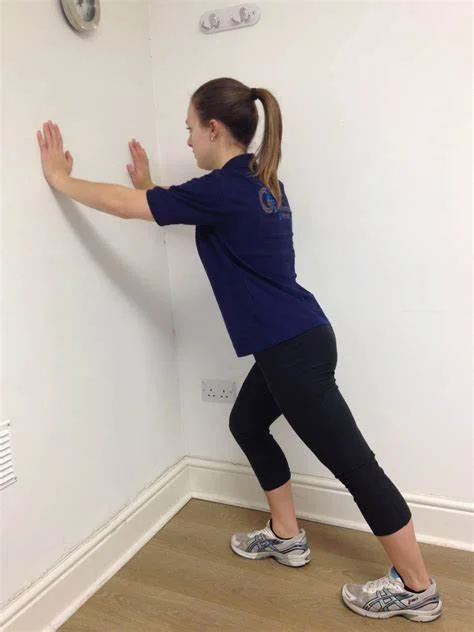
20. Inner Calf Stretch:
- Targets the inner calf muscle. Stretches the medial head of the gastrocnemius muscle (the inner side).
- Starting Position: Stand leaned against a wall, with your leg stretched back behind you.
- Action: Outside rotate the leg (turning it outwards) at the hip and subsequently lean ahead until you feel a stretch in the back of your calf, mostly on the inner side. Hold for 30 seconds, then continue three times.
- Notes: Make sure your knees are straight and you’re standing tall.
Strengthening Exercise of Calf Muscle:
- The calf is also overlooked in training, but it is an important muscle that controls the motion of the ankle joints. A strong calf can help prevent ankle injuries and improve foot motion, such as rising onto the toes, rotating your feet inward and outward, or pulling the toes towards the knees. These motions allow you to jump, run, and walk.
- Calf muscle strengthening exercises are an excellent way to increase the calf muscles’ power and strength while also improving their fitness. If you want to strengthen the calf muscles on the back of your leg, this article will be very helpful.
- In this article, we will discuss a few of the best exercises you can do at home to make your calf muscles powerful, as well as the health benefits of exercise.
- The calf is also overlooked in training, but it is an important muscle that controls the motion of the ankle joints. A strong calf can help prevent ankle injuries and improve foot motion, such as rising onto the toes, rotating your feet inward and outward, or pulling the toes towards the knees. These motions allow you to jump, run, and walk.
- Because the calf is responsible for the motion you perform every day, it is prone to injuries and strain. Strong calves and muscles can help rehabilitate existing injuries or prevent further damage to the lower limb
- If you have mobility issues, strengthening your calf muscles can help because they support tendons like the Achilles. People suffering from knee pain and plantar fasciitis can alleviate their symptoms by strengthening their calves as well. If you have any pains or injuries, consult a doctor before performing this exercise.
- Strong calves may improve your performance as an athlete, particularly during explosive bursts of power and speed, thanks to the calf’s fast-twitch muscle fibers. If the participants are involved in jumping or fast-moving sports such as basketball, soccer, sprinting, or cycling, it is recommended that they perform specific calf-strengthening exercises.
- Among the other muscles in your legs, the calve muscles, which are made up of the gastrocnemius and soleus, provide ankle joint stability. The gastrocnemius muscle is the more important part of the calf muscle that gives the shape you see. It has two heads that form a diamond shape with a split in the middle, which you can see if you build muscle and become lean. The soleus is a small muscle located beneath the gastrocnemius.
- Many calve exercises strengthen both the gastrocnemius and the soleus, while others target only one of them. Several weighted and bodyweight exercises will strengthen the calves’ muscles, but some cardiovascular exercises are especially beneficial. Do not forget to warm up with mobility exercises and cool down by stretching after the workout.
Benefits of Calf Strengthening Exercise
- A strong calf may boost performance.
- People who have knee pain or plantar fasciitis can alleviate their symptoms by strengthening their calves as well.
- The strength of your calf muscles determines your overall lower-body performance.
- Runners, if you want to increase your speed, do calf raises.
- Yes, calf raises are a big no for injuries.
- Stronger and more flexible calf muscles improve balance and stability.
- Helps to lower the risk of ankle as well as foot injuries.
- Improved agility while jumping and running.
- More explosive, rapid motion. An excellent exercise for runners.
- Calves exercise can also detect an older person’s ability to do daily tasks.
- This exercise helps to stabilize the feet and ankles
- The strength of your calves’ muscles determines your overall lower body performance.
Some strengthening exercises of the calf muscle:
- Seated Calf Raise
- Standing Dumbbell or Barbell Calf Raise
- Leg Press Machine Calf Raise
- Bodyweight Calf Raise
- Single-Legged Forward Leaning Calf Raise
- Jumping Calf Press
- Wall Sit Calf Raise
- Carioca Agility Ladder Drill
- Jump Rope
- Sprints
- Cycling
- Farmers Walk on Toes
- Plyometric lunges.
1. Seated Calf Raise
The seated calf raise requires access to the calf raise equipment. Another option is to hold something heavy in your lap, but this might not give enough load to work the muscles effectively. Because the knees are bent, the gastrocnemius is not utilized here. The seated calf raises activate the soleus muscle.
Step-by-step instructions:
- Sit on a calf raise machine, keeping your upper thighs under the pad. The pad should be just above your knees.
- The ball of your feet ought to rest on the footplate.
- Lower your heels as far as possible while keeping your feet on the balls.
- Slowly raise your heels and push your toes into the pad. Continue until you feel a stretch in your calves, then hold for one count before slowly lowering back to the starting position.
- Repeat 10 to 15 times.
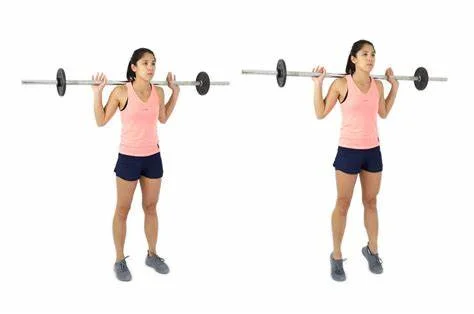
2. Standing Dumbbell or Barbell Calf Raise
- Standing dumbbell and barbell calf raises work the gastrocnemius muscle in the calves. This movement can be done on a workout step using weight plates according to the balls of your feet. Use dumbbells or a barbell, and complete the movement carefully and steadily.
Step-by-step instructions:
- Place your toes and balls of your feet on a step or weight plate. Your arches and heels should extend off the step.
- If you’re using a barbell, place it across your shoulders and on your trap muscles.
- Engage your core and keep your back flat as you lift your heels as high as possible.
- Pause at the top of the contraction for a count before gradually lowering yourself. Your heels should be below parallel but not touching the ground.
- Repeat 10 to 15 times.
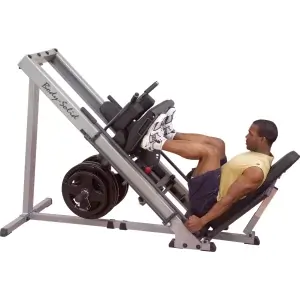
3. Leg Press Machine Calf Raise
Another option for calf raises at the gym is to use the leg press machine, especially if you do not have a seated calf raise machine or are uncomfortable using a barbell. The leg press machine provides support for your upper body, ensuring that you do not lose balance.
If you have a knee injury or soreness, skip this exercise.
Step-by-step instructions:
- Sit upon a leg press device, feet flat upon the plate, shoulder-width apart.
- Push the plate away from your body with the balls of your feet until your legs are nearly but not fully locked out.
- Drive with your toes in a tiptoe position for a count before returning to flat feet.
- Try ten to fifteen repetitions.
4. Bodyweight Calf Raise
The bodyweight calf raise is a simple exercise that targets your gastrocnemius. It can be done on an exercise step, stairs, or any stable, flat surface with an edge. You’ll probably want to keep something nearby that you can use for support.
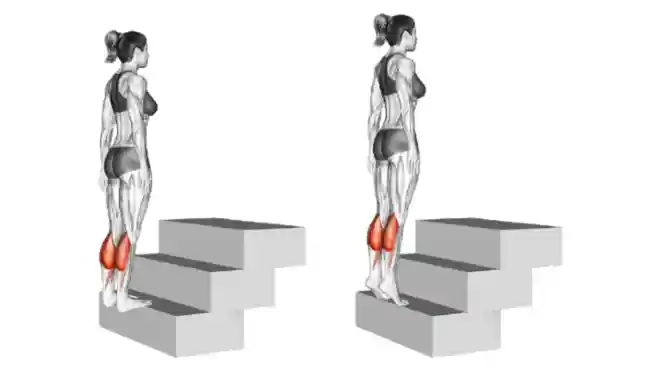
If using your weight is difficult, pull or push on your support to help. To make the exercise more difficult, try performing it with one leg at a time.
Step-by-step instructions:
- Stand tall, feet hip-width apart, and engage your core while maintaining a neutral back position.
- For balance, lean against a wall or support, or keep your hands at your sides.
5. Single-Legged Forward Leaning Calf Raise
To improve your calf raise exercise, try the single-leg forward-angled calf raise. You can use any stable flat surface or a barbell in a rack set to your desired height. A lower surface will lower the resistance.
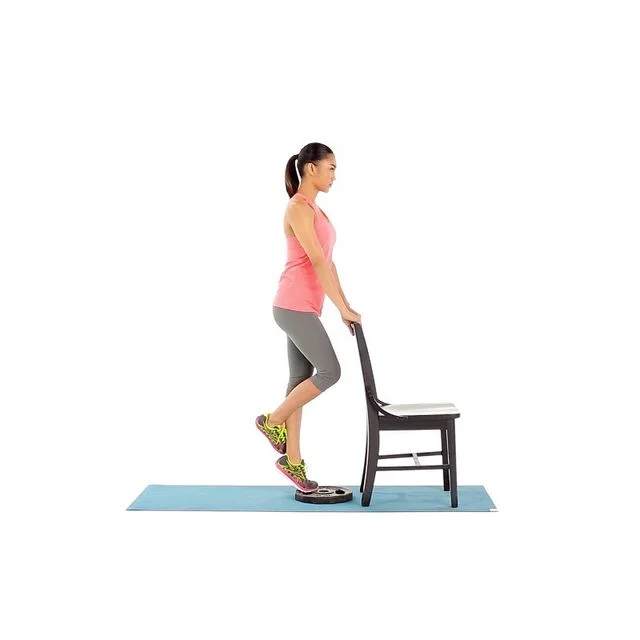
You can also try this with both feet at the same time, which makes it easier. This exercise primarily targets the gastrocnemius but also includes the soleus muscle.
Step-by-step instructions:
- Stand facing a vertical surface or a racked bar.
- Hold the handle with an overhand grasp that is wider than your shoulder width.
- Step your feet back to angle your body forward, maintaining a straight line with arms extended.
- Raise the heel of your standing leg by stretching your ankle as far as you can. Your body should move in a straight line up at an angle.
- Hold for a count, then feel the contraction in your working calf.
6. Jumping Calf Press
The jumping calf press, another great bodyweight exercise for your calves, is a plyometric exercise that will help you gain strength and explosiveness.
You have the option of jumping repeatedly in succession—jumping back up as soon as you land—or jumping once, landing, and waiting for a count before jumping again.
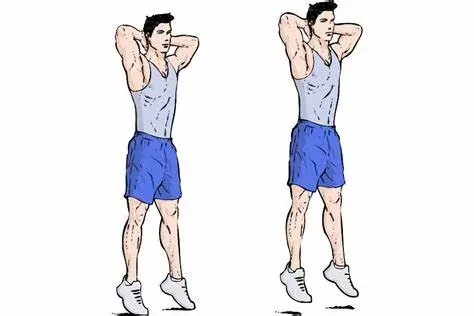
Step-by-step instructions:
- Stand in a natural position, hands at your sides, core engaged, back straight.
- To jump into the air, explosively press off the ground with the balls of your feet.
- Focus on the tension and contraction in your calf muscles rather than relying on your quadriceps to power your jump.
- Repeat ten times.
7. Wall Sit Calf Raise:
The wall sit calf raise can be done as an isometric exercise, holding the contraction for the entire time, or as a series of calf raise repetitions. Holding the exercise will help you gain strength and muscular endurance. For this exercise to be effective, proper form is essential.
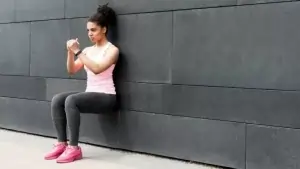
Step-by-step instructions:
- Stand with your back flat toward a wall and your feet approximately 2 feet from it.
- Slide your back down the wall while engaging your core until your thighs are at a 90-degree angle and parallel to the floor.
- Your knees ought to be just above your ankles and not your toes.
- Lift your heels off the ground and push through the balls as well as the toes of your feet.
- Hold your back flat against the wall for 20 to 60 seconds.
- Alternatively, you can lower your heels again and repeat the movement, raising them back up.
- If you are holding the exercise, repeat it three times with a 30-second rest in between.
8. Carioca Agility Ladder Drill
Agility ladder drills are a great functional fitness exercise that works the entire body and cardiovascular system. Agility ladder drills will primarily work your calves because you perform many of the moves with the balls of your feet while quickly moving through the rungs of the ladder. The Carioca drill relies heavily on your calf muscles to produce quick, explosive, and agile movements.
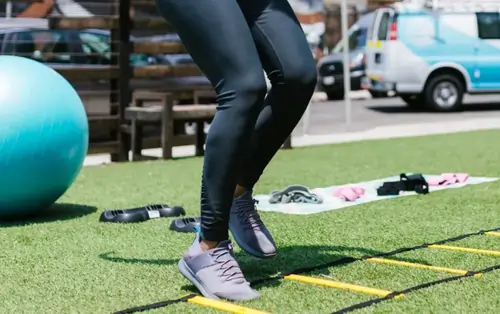
Step-by-step instructions:
- Stand on the right side of the agility ladder, then step sideways with your lead foot into the nearest box.
- Next, cross your rear foot behind your front foot and enter the second box.
- Continue switching your feet and stepping laterally across the ladder boxes while rotating your hips.
- Try to move your feet quickly and smoothly.
Repeat, going through the latter in the opposite direction.
9. Jump Rope
Jumping rope is an excellent cardiovascular exercise that also helps to strengthen your calves. Jumping repeatedly from the balls of your feet works the muscles in your calves, resulting in increased power, strength, and endurance.
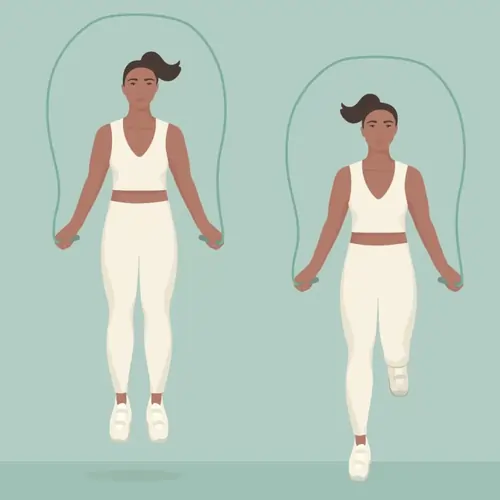
Step-by-step instructions:
- Hold a jump rope handle in both hands, with the middle of the rope behind you.
- The rope ends should be even with your hips and held away from your body.
- Rotate the wrists to swing the rope upwards and over your head.
- As the rope swings down in front of you, jump over
10. Sprints
Sprinting is a total-body workout, but the calf muscles will work overtime to propel you forward, particularly as you sprint uphill or down stairs. Always warm up with a gentle run with a few dynamic movements before sprinting, and stop if you experience pain.
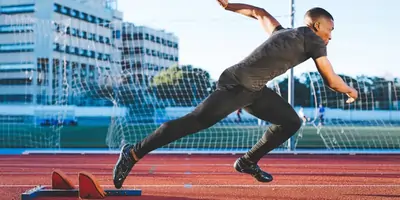
Step-by-step instructions:
- In a slight forward lean.
- Drive your dominant leg into the ground and take small, quick steps, gradually progressing to more explosive steps that are further apart.
- Pump your arms from chin to hip level to propel yourself forward.
- Lift your front knee with each stride and straighten your back leg to propel you forward.
- To avoid jarring your knees, slow down gradually before coming to a stop.
When you’ve finished your sprint, allow your heart rate to drop before repeating.
11. Cycling
Cycling, whether indoors or outdoors, is an excellent way to train your calf muscles without using weights. While weight training is essential for muscle development, cross-training with a cardiovascular activity like cycling can help you improve your calf strength and muscular endurance.
Here are some form tips to help you get the most out of your cycling for calf strength.
Step-by-Step Instructions:
- Adjust the seat on your bike, so you can lean forward and maintain a flat back when reaching the handlebars.
- Engage your core, bracing your abdominals along with your back muscles to provide support as you lean forward.
- Warm up by placing your bike in its highest gear.
- Push with the pedal rotation, keeping the tension on your legs as you push down.
- After some minutes, change the gear to a higher resistance and keep pushing with leg muscles, feeling the contractions and tension in your calves.
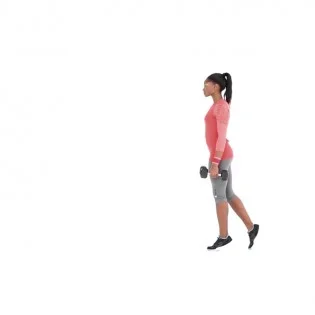
12. Farmers Walk on Toes
How do I do it?
- Grab heavy dumbbells by your sides.
- Get up on your toes as well as walk ahead for forty to fifty seconds.
- If you believe you could have lasted longer than 60 seconds, increase the weight. Do two or three sets.
13. Plyometric lunges.
How do I do it?
- Start standing, then take a step forward with your left foot and drop into a lunge, lowering your right knee to the ground.
- Push through the left heel to explode into a jump, then switch legs in mid-air to land in a lunge with the right leg forward.
- Use your arms for momentum. Repeat the lunge jump with the left leg.
- That’s one repetition. Perform two sets of 10-15 repetitions.
When didn’t you do this exercise?
If you have a knee or ankle injury, avoid these exercises.
If the leg bone has recently fractured.
If your healthcare provider advised you to rest.
How to achieve the best results:
- Before we begin, let’s take a brief look at how to get the best outcomes from stretches. Calf stretches are simple, but to be effective, you must follow a few guidelines:
- Hold for Longer: According to studies, the most efficient method to stretch is to hold calf stretches for 30 seconds. This gives the muscle fibers enough time to relax. Less than 30 seconds will result in minimal changes in muscle length.
- Calf stretches should be repeated at least three times for optimal results. Stretches will have little effect if done in small amounts. Also, doing more than three reps will provide minimal additional benefit.
- Take the Pain: Calf stretches should feel uncomfortable but not painful. Any discomfort should subside as soon as you stop stretching. Effective stretching is not particularly enjoyable!
- Stay safe: Calf stretches should not be performed immediately after an injury, such as a calf tear, as they can cause additional damage. Before beginning calf stretches, make sure you can push down through your toes against moderate resistance without pain. Always consult your doctor before beginning an exercise program following an injury.
- Correct Position: Due to the anatomy of the calf muscles, you must stretch each one separately. Gastrocnemius stretches feel more powerful than Soleus stretches.
Soleus: This calf muscle begins just below the knee and is stretched with the knee bent. - Gastrocnemius: This calf muscle originates above the knee, so when stretching it, keep the knee straight. The top of the muscle originates from two different locations: the medial (inner) as well as lateral (outer) heads. Gastrocnemius calf stretches may be performed either as a whole unit or to bias the two different heads.
What are some common mistakes to avoid during calf stretches?
Here are some mistakes to avoid when stretching your calf:
- Return to the ground immediately: The position of the legs should be slow and controlled for maximum effectiveness.
- Allowing pressure on the arms: There are numerous calf muscle stretches available; however, pressing from the arms will put unnecessary strain on the upper body with no benefit.
- Not Keeping the Back Extended: Try to keep your back extended and not slumped forward. Use a long towel, strap, or belt to avoid having to flex forward while stretching in a long sitting position.
- Calf Muscle Stretching: If you’re doing this stretch in the morning to relieve plantar fasciitis, do it before getting out of bed to loosen up before standing on the affected foot. Stretching should be done after warming up the calf muscles with walking and other workouts, though, for different purposes.
- Never bounce during a calf stretch because it can cause muscle injuries.
What are the safety and precautionary measures for calf muscle exercise?
There are many safety issues you must follow:
- If you have a history of injury or chronic pain in your legs, back, or hips, consult a doctor or physical therapist before beginning any exercise program. After an injury, do not stretch until you can push your toes down against the ground without pain.
- While stretching, you will feel muscle tension but no pain. If you experience pain, discontinue the stretching exercise.
- After an injury, do not stretch until you can push your toes down against the ground without pain.
- Do not perform if you have ankle or foot injuries.
FAQs
How do I strengthen my calf muscles?
Calf muscles can be strengthened through a variety of weighted and bodyweight exercises, but some cardiovascular exercises are especially beneficial. Remember to warm up with mobility exercises and cool down with stretching after your workout. The seated calf raise requires access to the calf raise machine.
How do I do a seated calf raise?
The seated calf raise requires access to the calf raise machine. Another option is to hold something heavy in your lap, but this may not provide enough load to work the muscles effectively. The gastrocnemius is not used in this position since the knees are bent. The soleus muscle is worked during the seated calf raise.
What muscles do calf stretches work?
The calf muscle pulls the foot down (plantarflexion) and stabilizes the ankle. As we walk, run, and jump, the calf muscle pulls the heel up, providing the power we need to push ourselves off the ground. Calf stretches ensure that the muscles can function optimally.
What is a good bodyweight exercise for calves?
The jumping calf press, another great bodyweight exercise for your calves, is a plyometric exercise that will help you gain strength and explosiveness. You have the option of jumping repeatedly in succession—jumping back up as soon as you land—or jumping once, landing, and waiting for a count before jumping again.
Are calf raises a good workout?
Seated exercises are ideal for isolating the calf muscles and increasing strength with heavy lifting. Calf raises naturally strengthen these muscles, but they can also help your legs appear more sculpted. They can also help you with your running, jumping, and everyday activities like climbing stairs.
REFERENCES:
- Leg muscles: Overview. (2023, November 3). Kenhub. https://www.kenhub.com/en/library/anatomy/leg-muscles
- Inverarity, L. (2022, July 7). Calf Muscle-Strengthening Exercises. Verywell Health. https://www.verywellhealth.com/calf-muscle-strengthening-2696606
- Cpt, R. M. B. (2021, May 24). The 12 Best Exercises to Strengthen Your Calves. Verywell Fit. https://www.verywellfit.com/the-12-best-exercises-to-strengthen-your-calves-5184522
- Valand, B. (2022, October 9). Calf muscle exercises Stretching & Strengthening Exercise. Samarpan Physiotherapy Clinic. https://samarpanphysioclinic.com/calf-muscle-exercises/#What_is_the_calf_muscle
- 7 Great Calf Stretches For Tight Muscles – Foot Pain Explored. (n.d.). Foot-Pain-Explored.com. https://www.foot-pain-explored.com/calf-stretches.html
- Binstead, J. T. (2023, May 23). Anatomy, Bony Pelvis, and Lower Limb: Calf. StatPearls – NCBI Bookshelf. https://www.ncbi.nlm.nih.gov/books/NBK459362/
- Professional, C. C. M. (n.d.). Calf Muscle. Cleveland Clinic. https://my.clevelandclinic.org/health/body/21662-calf-muscle
- Inverarity, L. (2022, July 7). Calf Muscle-Strengthening Exercises. Verywell Health. https://www.verywellhealth.com/calf-muscle-strengthening-2696606
- McIntyre, M. (2023, June 28). The 10 Best Calf Exercises. Jacked Gorilla. https://jackedgorilla.com/best-calf-exercises/

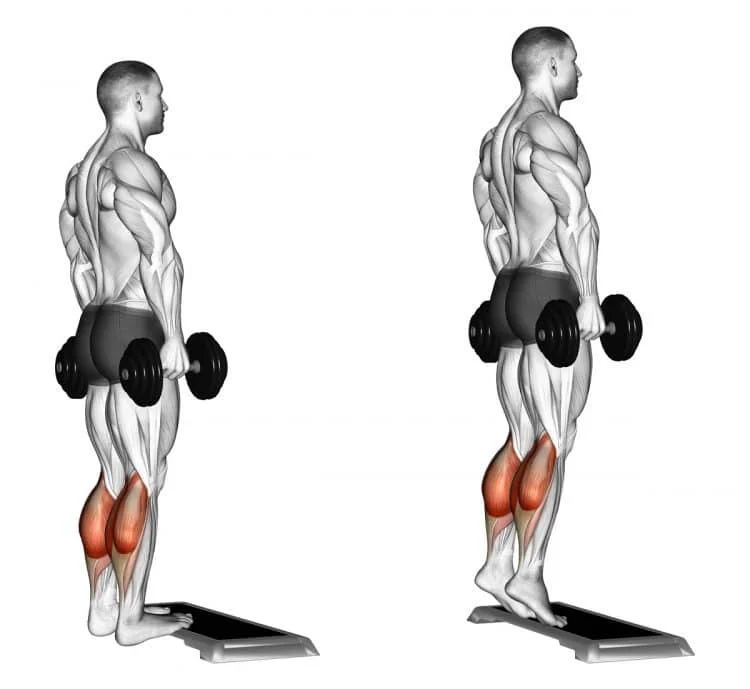
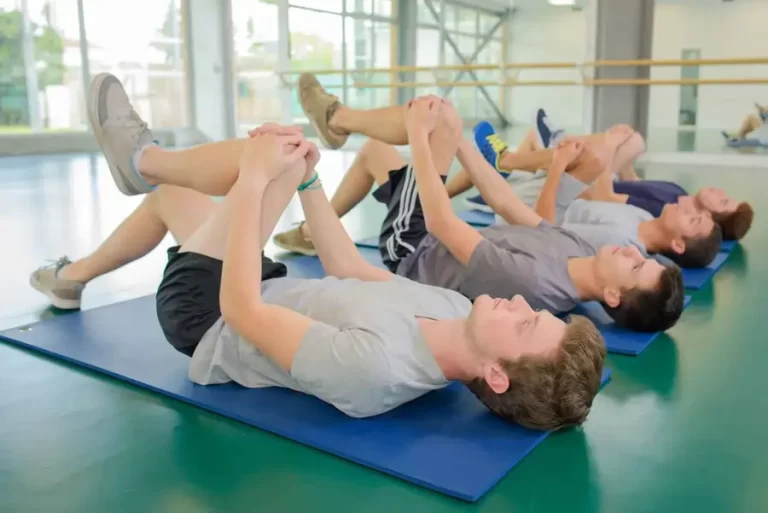
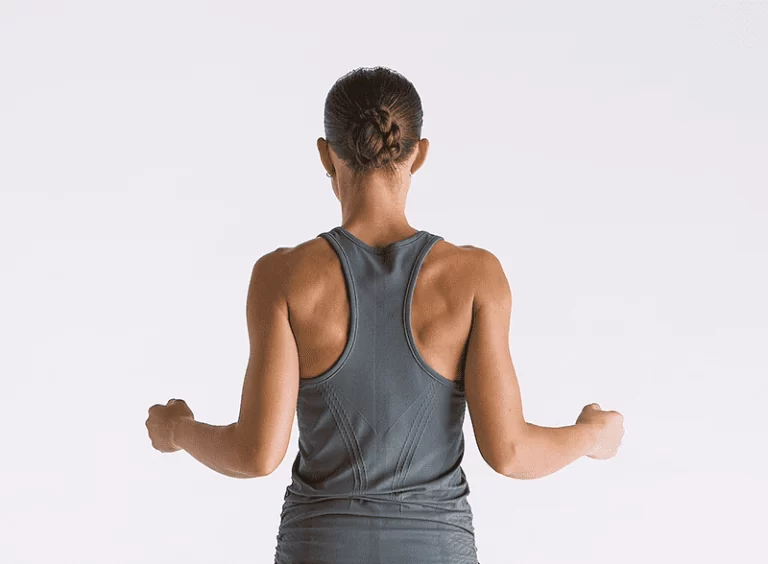
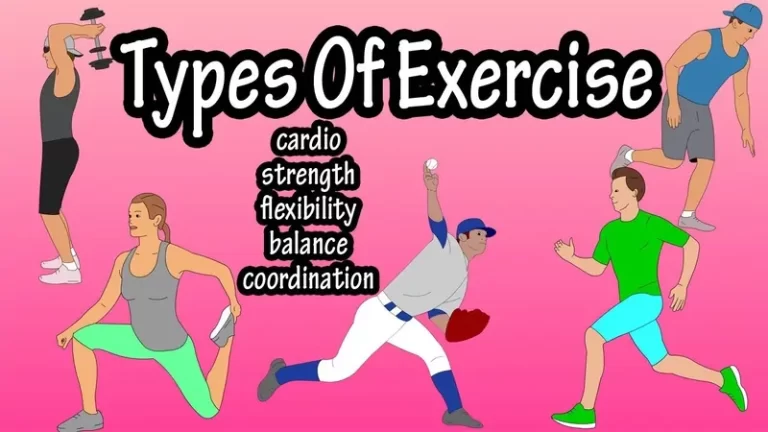
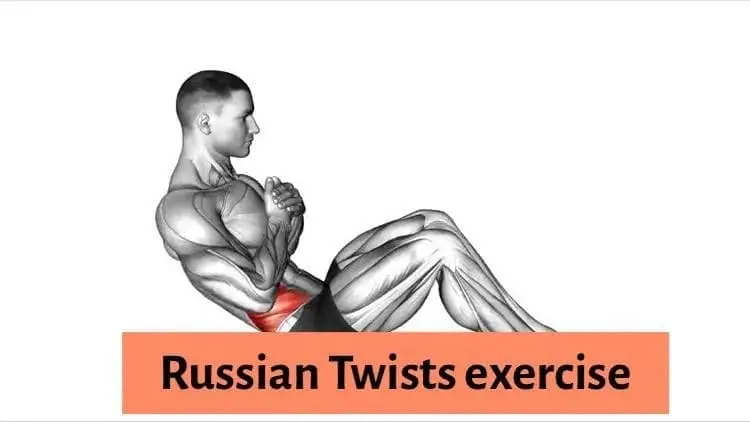
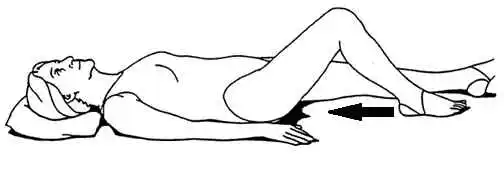
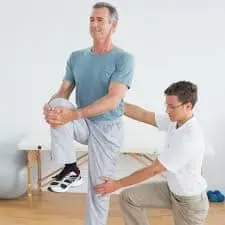
One Comment